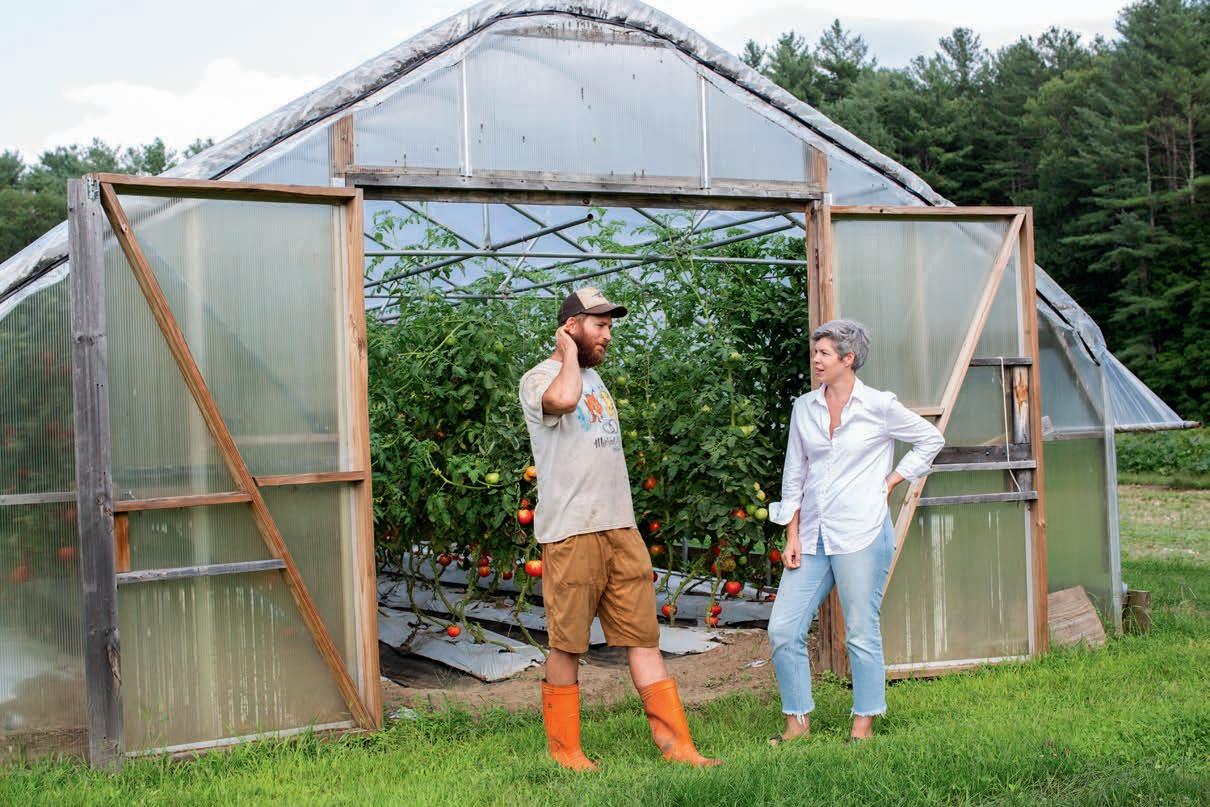
3 minute read
THEJEWEL S OF SUMMER
At New Hampshire’s Edgewater Farm, the late summer tomato harvest is the sweetest season of all.
BY JESSICA BATTILANA
Ray Sprague disappears for a second, then pops up at the end of a row between two towering Purple Russian tomato plants. He’s holding an oblong, deep-red fruit. “This one’s my favorite,” he says with a grin, before encouraging me to bite into it like an apple. I oblige, spraying juice and seeds down my shirt: There’s nothing quite like a ripe, sun-warmed summer tomato.
It’s August at Edgewater Farm, a 220-acre swath of alluvial soil in Plainfield, New Hampshire. The fields are full, the farm stand abundantly stocked. It’s a time of riotous profusion. The greenhouses, where a majority of the 60 varieties of tomatoes are grown, resemble jungles, with some tangles of plants dwarfing even Sprague, who stands 6 foot 5. Stems bend beneath the weight of tomatoes of every size and description, ranging from tiny orange Sun Gold to Chile Verde, a green-fleshed tomato with a blush of yellow. Out in the fields, the red slicing tomatoes ripen under the long hours of sunlight.

The farm was founded in 1974 by Sprague’s parents, Pooh and Anne Sprague, who continue to run the business with Ray and his sister, Sarah. What began with ornamental plants, strawberries, and asparagus has blossomed into a diversified operation with pick-your-own strawberries, a CSA, and a wholesale operation that sells produce to the greater Upper Valley region. At the timber-framed seasonal farm stand, visitors can select choice produce and stock up on farm-made pesto, salads, and frozen entrées packed full of Edgewater vegetables.
Every crop receives attention, but Sprague admits that he’s “gotten a little nutty” about the tomatoes, particularly the 40 or so heirloom varietals and 10 types of cherry tomatoes he plants each season. The work begins in March, when he starts the process of grafting each heirloom tomato seedling onto a rootstock to improve the plant’s vigor. After some time in the propane-heated greenhouses, and once the threat of frost has passed, the starts are transplanted directly into the nutrient-rich soil. With luck, cooperative weather, and the tempering effects of the greenhouses, the Edgewater team will be picking the first tomatoes around Independence Day and the last in November—an impressive run, by New England standards. In a single season, each 21-by-96-foot greenhouse cranks out between 4,500 and 7,000 pounds of tomatoes.
Sprague’s obsession is a boon for his customers. In the height of summer, it’s not uncommon to see a kaleidoscopic array of tomatoes for sale at the farm stand: fat, heavy slicers ready for a BLT; jewel-like cherries to be eaten in the car on the way home; tomatoes perfect for risotto or for a simple herb-packed salad. A far cry from the pale red baseballs that flood the markets in the colder months, these tomatoes—picked ripe and, Sprague stresses, never refrigerated— are the jewels of summer, as precious as any gem.
VIETNAMESE-STYLE
Tomato Salad With Herbs And Fried Shallots

Fresh tomato salads are among the best ways to highlight summer’s most beloved fruit. Instead of opting for the traditional mozzarella-and-basil combination, this salad draws inspiration from Vietnam, with a punchy vinaigrette, whole leaves of mint and cilantro, and a golden crown of irresistible crispy fried shallots.
FOR THE DRESSING
¼ cup fish sauce (such as T hree Crabs brand)
2 t ablespoons granulated sugar
2 t ablespoons fresh lime juice
1 clove garlic, minced
1 T hai chili, stemmed and minced, or half a serrano pepper, stemmed and minced
FOR THE SALAD
2 cups canola oil
4 shallots, peeled and thinly sliced
4 cups cherry tomatoes, halved
¼ cup chopped mint leaves
¼ cup chopped cilantro leaves
Kosher salt, to taste
First, make the dressing: In a small jar with a lid, combine fish sauce, sugar, lime juice, garlic, chili, and ¼ cup warm water. Seal and shake vigorously until the sugar has dissolved. Set aside. (The dressing will keep, refrigerated, for up to a week, though it gets spicier as it sits.)
Next, make the fried shallots: Pour the oil into a 2- or 3-quart heavybottom saucepan over medium heat and add the sliced shallots to the cold oil. Line a plate with paper towels and set nearby. Fry the shallots, stirring frequently so they cook evenly, until they begin to brown, 6 to 8 minutes. Continue cooking, stirring constantly, until they are crisp and an even golden brown (at this stage they can go from nicely browned to overcooked very quickly, so be vigilant). Use a slotted spoon to transfer the shallots to the paper-lined plate. Let the oil cool, then pour through a finemesh sieve into a clean jar. (Do not discard the oil—it’s liquid gold, great for dressings and sautéed or roasted vegetables.) Store in an airtight container at room temperature.
Assemble the salad: Combine the tomatoes and herbs in a serving dish. Drizzle in some dressing and toss gently to coat. Season to taste with salt, if needed. Top with shallots and serve immediately, with any remaining dressing alongside. Yields 6 servings.
OVEN-ROASTED TOMATO AND RICOTTA TOASTS
Roasting tomatoes with lots of olive oil and aromatics concentrates their sweetness, yielding silky flavor bombs with myriad applications. Toss them into pasta, pile them onto a sandwich, stir them into a grain salad, or do as I’ve done here and use them as a topping for toasted bread slathered in good ricotta cheese.








